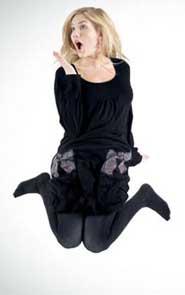 The German designer Anna Scholz runs the only high-end brand in the UK making fashionable clothes in larger sizes
The German designer Anna Scholz runs the only high-end brand in the UK making fashionable clothes in larger sizes
There are around 60 brands in Britain that cater to women who are size 16 and above (the not entirely enticingly named plus-size band), but only one designer range.
Given that around 50 per cent of British women fall into this category, it's hard not to see the germ of a fabulous business opportunity here - and at a time when fabulous business opportunities are about as thin on the ground as Paris Hilton's thoughts on monotheism. Eureka. If you care about struggling fashion designers, wouldn't you advise them to start cutting their clothes more generously now?
Yet curiously, the size 16 and above road is not paved with gold, as I discovered when I skipped along to Anna Scholz's studio one sunny afternoon not so long ago. Viewers of the hit BBC series Mary, Queen of Shops may recall an episode in which Scholz shone like a brightly coloured deed in a drab, depressed world of outsize (an even worse name) tents.
It's no overstatement to say that in that programme, Scholz single-handedly saved the life of the plus- size boutique run by a woman who, memorably, appeared to despise anyone bigger than she was. Which is to say almost everyone. The striking thing, it transpires, is that that owner's attitude isn't unusual. Selfridges has closed its outsize department. Harrods left the renovation of its plus-size area until the very last. Meanwhile, when was the last time you saw a model who was more than size 10 in a glossy fashion spread?
I don't exempt myself or these pages from this momentary scrutiny, by the way. I've been meaning to visit Scholz in her studio for the past five years, but somehow never got round to it - although her clothes probably have more practical relevance to many readers than some of the catwalk shows I've covered. But should fashion always place practicality above creativity? The bald fact is that, bank accounts and houses aside, nothing preceded by a plus sign is perceived as aspirational in today's society. Not even IQ scores.
That may all change, of course, now that we're supposed to be Discovering The True Values in Life. “Research” (I think they read a lot of Playboys) released by scientists at the weekend suggested that during economic downturns men find heavier women more attractive - and also that hungry men like big women. The former theory is just about creditable - it's the nurturing mamma mia thing, presumably. But the latter? What are these hungry men thinking? That there's more meat on a big woman if things get really desperate and the Snickers run out?
While I leave that thought dangling, the March 2006 issue of the Journal of Consumer Research published findings from Tilburg University in the Netherlands and Arizona State University which suggested that, contrary to many assumptions, looking at moderately heavy models lowers most women's self-esteem, while looking at moderately thin models raises it.
So it's all very contradictory and subliminal, and what women think they admire in other women's bodies is often the product of political correctness rather than biological reality. Pay your money and pick your image.
Back in Scholz's studio, she's doing nicely - sales of her clothes in Harrods, notwithstanding the tardy revamp, are 88 per cent up on last season. But her 21-year journey from her home town of Dusseldorf to her current niche in London, via a stint as a larger model and a degree at Central St Martins where, predictably, she was the only fashion student to produce a plus-size range for her graduate collection, has not been without its struggles.
It's not that that the tutors at St Martins weren't encouraging,” Scholz says, “but blocks in those sizes didn't exist.” She had to get them made, a cost that other students simply didn't have to incur. And her margins have been squeezed ever since. “We manufacture in nine sizes: 12 to 26, in cashmere and silk, mainly, which makes our production costs high,” she says, with a certain air of resignation.
Scholz has encountered plenty of resistance from department stores in her time, but is clearly a woman with a mission. “It took ages for the stores to buy our more colourful designs. The only way I could get them on the rails was to offer them sale or return. For the first ten years I was in business, my accountant kept asking why I bothered. But in the past two years we seem to have turned a corner.
We get so many letters from desperate women,” she continues. “One was on Prozac, she was so depressed at the lack of choice out there.”
Scholz herself is 6ft (1.83m) tall, and struggled in her modelling days to keep down to a size 18. “The problem is that other ranges want big women to apologise. It's always about disguising and concealing, never about celebrating. I don't understand it. Why would anyone want to wear a breast minimiser?”
At trade fairs Scholz's colourful, print-laden stand still shines out like a beacon amid clothes that, as she puts it, are designed for women who haven't had sex for 20 years and aren't looking to change that state of affairs. But nowadays she has enough orders to relish her splendid isolation.





